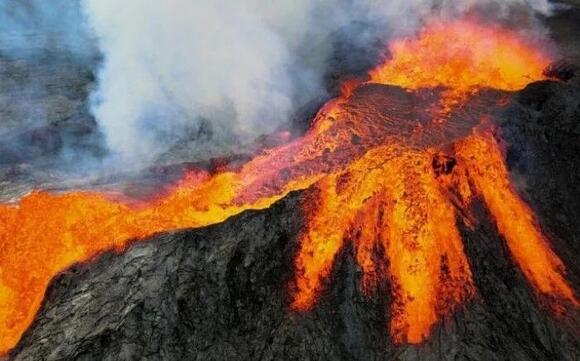
(The Center Square) Volcanoes in Iceland that are about 70 million years old may still be erupting years from now, researchers from the University of Oregon concluded.
Volcanoes on the country's Reykjanes Peninsula threaten the densely populated country. Local authorities declared a state of emergency in response to the eight series of volcanic eruptions that have happened since 2021, as 70% of the country lives in the southwest region. Plus, the region is home to the country's lone airport and many of its geothermal power plants that provide Iceland with hot water and electricity, according to the University of Oregon.
An eruption in May through June caused residents and visitors of the Blue Lagoon geothermal spa to evacuate for the third time in about two months.
Iceland sits on a volcanic hot spot, hence why it sees volcanic eruptions, but the Reykjanes Peninsula volcanoes have been dormant for 800 years.
"Its last volcanic era continued over centuries , however, prompting scientists to predict the renewed volcanism to be the start of a long episode," a release said.
Less than an hour from Reykjavík, the country's capital city, eruptions pose the risk of economic disruption and evacuated communities remain uncertain about a potential return.
An international team of scientists has observed these volcanoes for three years, looking at seismic tomography imaging and the composition of lava samples. These scientists have seen parts of the geological processes behind the new volcanic era. They think the region may need to prepare for recurring eruptions that last for decades or even centuries.
The researchers's findings were published in the journal Terra Nova on June 26. Collaborators on the project included people from the University of Oregon, Uppsala University in Sweden, the University of Iceland, the Czech Academy of Sciences, and the University of California, San Diego. Their research follows up on a Nature Communications study of the initial Reykjanes eruptions in 2021.
The work was funded by taxpayers in Sweden, Iceland and the Czech Republic.
Nearly all of Iceland’s island is built from hardened lava, according to Ilya Bindeman , a volcanologist and earth sciences professor at the University of Oregon.
Sitting on the Mid-Atlantic Ridge, Iceland exists where there is a tectonic plate boundary, pushing North America and Eurasia further apart.
"The drifting of these plates can spark volcanic eruptions when hot rock from the earth’s mantle — the middle and largest layer of the planet — melts and rises to the surface," the release said.
Scientists know the origin of Reykjanes Peninsula’s current eruptions is plate movement. However, it remains unknown what kind of magma storage and plumbing systems feed them.
"The peninsula consists of eight volcanically active sites, so understanding whether there is one shared magma source or multiple independent ones and their depth can help predict the duration and impact of these eruptions," the release said.
The researchers used geochemical and seismic data to investigate if magma from the initial eruptions from one volcano in the peninsula from 2021 to 2023 originated from the same source as the magma in the recent eruptions of a different volcano further west.
Bindeman's specialty is isotopic analysis -- something that can help identify the magma's fingerprint. The combination of trace elements can help differentiate between magma sources.
"Analyzing samples of lava rock from two different volcanoes in the peninsula, their similar fingerprints implied a shared magma storage zone below the peninsula," the release said. "Imaging of Earth’s interior based on local earthquakes also suggested the existence of a reservoir about 5.5 to 7.5 miles in the Earth’s crust, the shallowest layer."
Even so, the storage is fed by the rock melting deeper in the mantle. This may cause eruptions lasting decades where hundreds of miles of magma surface, the release said.
"Iceland's hotspot also will have no problem fountaining that flow," the release said.
Though this is the start of possibly regular volcanic incidents in Iceland, the researchers say they cannot accurately predict how long they will last.
“Nature is never regular,” Bindeman said in the release. “We don't know how long and how frequently it will continue for the next ten or even hundred years. A pattern will emerge, but nature always has exceptions and irregularities.”
Discussions on plans to safely drill into these volcanic sites to gain insights into their geological processes causing the eruptions are happening.
Since the volcanic activity in Iceland is less volatile and explosive than eruptions elsewhere globally, they provide researchers with a unique opportunity to witness fissures actively erupting lava.
“When you witness a volcanic eruption, you can feel that these are the massive forces of nature, and you yourself are very small,” Bindeman said in the release. “These events are ordinary from the geological scale, but from the human scale, they can be devastating.”
 Most Popular
Most Popular

Comments / 0